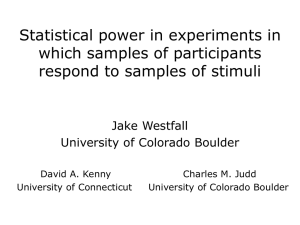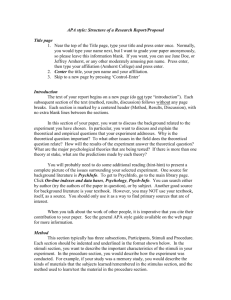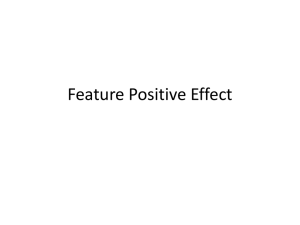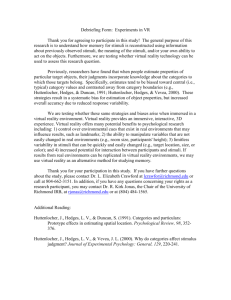draft 2 segl - Open Research Exeter (ORE)
advertisement
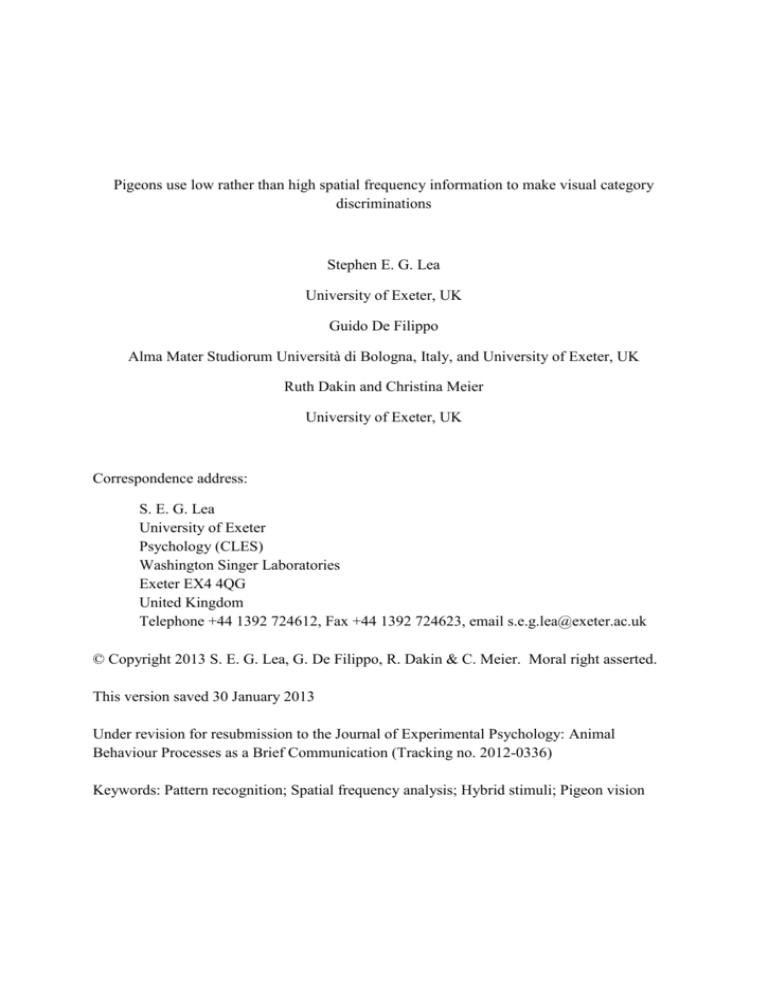
Pigeons use low rather than high spatial frequency information to make visual category discriminations Stephen E. G. Lea University of Exeter, UK Guido De Filippo Alma Mater Studiorum Università di Bologna, Italy, and University of Exeter, UK Ruth Dakin and Christina Meier University of Exeter, UK Correspondence address: S. E. G. Lea University of Exeter Psychology (CLES) Washington Singer Laboratories Exeter EX4 4QG United Kingdom Telephone +44 1392 724612, Fax +44 1392 724623, email s.e.g.lea@exeter.ac.uk © Copyright 2013 S. E. G. Lea, G. De Filippo, R. Dakin & C. Meier. Moral right asserted. This version saved 30 January 2013 Under revision for resubmission to the Journal of Experimental Psychology: Animal Behaviour Processes as a Brief Communication (Tracking no. 2012-0336) Keywords: Pattern recognition; Spatial frequency analysis; Hybrid stimuli; Pigeon vision Author Note We thank Catherine Bryant for developing the initial version of the client program used, Catriona Ryan for animal care, and her, Andy Wills and Ian McLaren for discussion. Address correspondence to Stephen Lea, Psychology (CLES), University of Exeter, Washington Singer Laboratories, Exeter EX4 4QG, UK. Email: s.e.g.lea@exeter.ac.uk Lea et al, Pigeons use low spatial frequencies: Page 1 of 17 1 Abstract 2 Pigeons were trained to discriminate photographs of cat faces from dog faces. They were 3 then presented with test stimuli involving high- and low-pass spatial frequency filtering. 4 Discrimination was maintained with both types of filtered stimuli, though it was increasingly 5 impaired the more information was filtered out, and high-pass filtering impaired 6 discrimination more than low-pass filtering. The pigeons were then exposed to hybrid stimuli 7 in which high-pass filtered dog faces were combined with low-pass filtered cat faces, and 8 vice versa. Response to hybrid stimuli was determined more by the low spatial frequency 9 content than by the high frequency content, whereas humans viewing the same stimuli at 10 corresponding viewing distance respond more strongly to the high-frequency content. These 11 results are unexpected given that, compared with humans, pigeons’ behavior tends to be 12 controlled by the local details of visual stimuli rather than their global appearance. Lea et al, Pigeons use low spatial frequencies: Page 2 of 17 13 Pigeons use low rather than high spatial frequency information to make visual category 14 discriminations 15 Consider the stimulus shown at the center of the bottom row of Figure 1. When viewed from 16 a distance, it appears to be a cat’s face; but if it is sufficiently magnified on a computer 17 screen, a dog’s face becomes the dominant percept. Figure 1 shows how these “hybrid 18 stimuli” (Schyns and Oliva, 1994) are constructed. The “parent” cat’s face is subjected to 19 low-pass spatial frequency filtering, while the parent dog’s face is high-pass filtered, and the 20 two filtered stimuli are added together. The effect depends on our differential sensitivity to 21 different bands of spatial frequency. At a small size, our visual systems respond to the lower 22 spatial frequencies, so we see the cat’s face. As we enlarge the image, all the spatial 23 frequencies are lowered, and eventually those present in the dog’s face reach the range to 24 which we are most sensitive, and we see the dog. Oliva, Torralba and Schyns (2006) show 25 some striking examples of such stimuli. 26 Insert Figure 1 about here 27 Analysis of visual input in terms of spatial frequency allows a systematic approach to the 28 problem of form perception: all the pattern information present in a visual stimulus is 29 preserved in its spatial frequency spectrum, but in a more tractable form. Such spatial 30 frequency analysis, and differential treatment of different frequency bands, has been argued 31 to be a fundamental property of the visual system of humans (Campbell & Robson, 1968; 32 Blakemore & Campbell, 1969). The approach has been extended to other animals including 33 birds (Hardy and Jassik-Gerschenfeld, 1979). However, it is not known how non-human 34 species would respond to the kind of hybrid stimuli shown in Figure 1. The question is 35 particularly interesting in relation to pigeons, since their visual cognition has been shown to 36 differ from that of humans in ways that might be explained by different sensitivity to Lea et al, Pigeons use low spatial frequencies: Page 3 of 17 37 particular spatial frequencies. Pigeons tend to respond to local details of stimuli in situations 38 where human behavior is more determined by the Gestalt (Cook 1993). For example, faced 39 with hierarchical stimuli like those of Navon (1977), which humans classify in terms of 40 global properties, pigeons classify them in terms of the elements of which they are composed 41 (Cavoto & Cook, 2001). Faced with stimuli in which a small diamond sometimes does, and 42 sometimes does not, fit exactly into a notch in the perimeter of a large square, pigeons detect 43 the notch with equal ease regardless of whether the diamond is fitted into it, whereas humans 44 find the task harder when the diamond fits into the notch, since we then see the image as a 45 diamond superimposed on an intact square (Fujita and Ushitani, 2005). If pigeons are trained 46 to discriminate between images of cats and dogs, and are then faced with chimeras made up 47 of cat heads on dog bodies or vice versa, they classify them in terms of the body (Ghosh, Lea 48 & Noury, 2004, Experiment 1) whereas human infants classify them in terms of the head 49 (Quinn & Eimas, 1996). 50 To explain these and related results, Ghosh et al (2004) and Goto, Lea, Wills and Milton 51 (2011) suggested that, compared with humans, pigeons may be more sensitive to the higher 52 spatial frequencies in a stimulus. The present experiment tests this account directly. As in 53 Ghosh et al (2004, Experiment 2) and Goto et al (2011), pigeons were trained to discriminate 54 between images of the faces of cats and dogs. They were then tested with stimuli that were 55 either low-pass or high-pass filtered in the spatial frequency domain, and with hybrid stimuli 56 composed as in Figure 1. 57 Method 58 Subjects 59 Eight pigeons, obtained as discards from local fanciers, were kept in an indoor aviary and 60 maintained at or above 80% of free feeding weight. They had previously served in another Lea et al, Pigeons use low spatial frequencies: Page 4 of 17 61 experiment on visual pattern discrimination, using similar training and testing procedures but 62 with stimuli of completely different appearance. 63 Apparatus 64 Each pigeon was tested in one of four 71 x 50.5 x 43.5 cm operant chambers. One long wall 65 of each chamber was fitted with a 31 x 23.5 cm (15-in.) touch monitor (Model 1547L 1024 x 66 768 pixel TFT monitor with CarrollTouch infra-red detector; ELO Touchsystems Inc.), 67 mounted 12 cm above the grid floor of the chamber. Effective pecks to target areas were 68 followed by an immediate bleep from a 50-ohm loudspeaker, which also played white noise 69 into the box. Two 2.8-W white houselights were mounted above and to either side of the 70 screen. Two 6 x 5-cm apertures gave access to grain hoppers when solenoids were activated; 71 they were located directly below the houselights and 4 cm above the floor of the chamber. 72 The hoppers were illuminated by a 2.8-W white light when activated, and contained a 2:1 73 mixture of hemp seed and conditioner. The interior of the box was monitored by a video 74 camera. The experiment was controlled by a computer (Quadvision Ltd) located in an 75 adjacent laboratory area, using the Whisker control server system (Cardinal & Aitken, 2010) 76 with client programs written in Microsoft ® Visual Basic 6.0. 77 Stimulus materials 78 The training stimuli were full-color cat and dog face images on black backgrounds, as used 79 by Ghosh et al (2004) and Goto et al (2011). There were ten cat faces and ten dog faces, with 80 each cat face paired with a particular dog face for the purposes of producing the hybrid 81 transfer stimuli described below. Where possible, paired faces were roughly matched in 82 terms of overall brightness, hue, and orientation, though the extent to which this could be 83 done was variable. The faces were selected so that the range of variation of luminance and 84 hue within categories was much greater than the mean differences of those properties Lea et al, Pigeons use low spatial frequencies: Page 5 of 17 85 between categories. Images fitted within a 100 x 100 pixels (3.1 x 3.1 cm) square, subtending 86 approximately 60° of arc at the pigeon’s eye at typical pecking distance. All images are 87 shown in the Electronic Supplementary Materials (Fig. E1), and information about their 88 spatial frequency content has been reported in the Supplementary Material for Goto et a 89 (2011). 90 Low-pass spatially filtered versions of a stimulus can be produced by convolving the 2- 91 dimensional matrix of its pixel values for each color channel (red, green or blue) with a 92 smaller square matrix populated with unit values, called a filter kernel (Walisch, Lusignan, 93 Benayoun, Baker, Dickey, and Hatsopoulos, 2009, pp. 87ff). In simple terms, this blends the 94 pixel values across the area of the kernel, and thus removes high spatial frequency 95 information; but it does so without producing the sharp boundaries (and, therefore, artefactual 96 high spatial frequencies) that result from Harmon’s (1973) mosaicization procedure. For the 97 present experiment, convolution was carried out using the convn routine within Matlab® 98 R2008a with filter kernels of size 5, 10 and 20 pixels, which removed spatial frequencies 99 above 0.20, 0.10 and 0.05 cycles/pixel respectively. 100 High-pass filtered stimuli can then be produced by subtracting the low-pass filtered stimuli 101 from the originals, leaving only the high spatial-frequency information. However, this 102 procedure also results in a very low intensity image, so to restore the typical intensity, neutral 103 grey was added to the high-pass images by adding half the maximal value to all pixel values, 104 as recommended by Walisch et al. In order to retain the same general appearance in the 105 transfer as in the training stimuli, the grey was then removed from the area of the original 106 image’s black background. Lea et al, Pigeons use low spatial frequencies: Page 6 of 17 107 Hybrid images were constructed by adding a low-pass filtered dog face image to the high- 108 pass filtered image of the cat face with which it was paired (or vice versa), after removal of 109 the neutral grey from the high-pass image. 110 Figure 1 shows the test stimuli made from one cat/dog pair with each filter cut-off frequency; 111 the complete sets of test stimuli are shown in the Electronic Supplementary Material (Figs. 112 E2-E4). It should be noted that, because the parent stimuli were 100-pixel square bitmap 113 images, even the parent stimuli had already been subjected to spatial frequency filtering, in 114 the sense that no information at a spatial frequency above 0.5 cycles/pixel (the Nyquist limit, 115 see Walisch et al., 2011, chap. 7) or below 0.01 cycles/pixel (the reciprocal of the overall 116 width of the image) could be represented in them. 117 To establish that discrimination and transfer could not be based on the frequently highly 118 salient dimensions of brightness and color, mean values of red, blue and green intensities at 119 each pixel were calculated for each training and transfer stimulus. These means were then 120 converted to measures of overall luminance (the sum of the pixel values for the three 121 channels), redness (the red pixel value minus the green pixel value) and blueness (the blue 122 pixel value minus the mean of the red and green pixel values). The measures were expressed 123 as percentages of their maximum possible values. The relation of these percentage values to 124 perceived brightness and hue can be assumed to be monotonic. 125 The training cat faces had somewhat higher overall luminance on average than the training 126 dog faces (35.1% and 31.3% of maximum values, respectively), but the difference was small 127 compared with the range within each category (27% for cats and 25% for dogs). The 128 differences in mean redness and blueness between cat and dog faces were less than 1%, 129 compared with within-category ranges of 10% to 17%. Lea et al, Pigeons use low spatial frequencies: Page 7 of 17 130 The effects of filtering on overall luminance and color were similar for both cat and dog face 131 stimuli. High-pass filtered stimuli had somewhat higher luminance than the training stimuli 132 (by a mean of 4.5%), and low-pass filtered stimuli somewhat lower (by a mean of 3.5%). 133 The high pass filtered stimuli were somewhat less saturated than the training stimuli (both 134 redness and blueness closer to zero by approximately 3%), and the low pass stimuli 135 correspondingly more saturated. Filtered stimuli did not differ from training stimuli in hue. 136 Hybrid stimuli tended to have slightly lower luminance than training stimuli (by a mean of 137 4.6%) but did not differ from them in hue. 138 To assess whether the cat and dog images could be discriminated on the basis of overall 139 luminance or hue, the rho statistic of Herrnstein, Loveland and Cable (1976) was used to 140 assess the overlap between the two categories. This statistic, which was also used to assess 141 the birds’ discrimination performance, takes a value of 0.5 for random assortment, and 1.0 for 142 perfect separation of two categories. For overall luminance, the rho value for the 143 discriminability of cat and dog faces was 0.66, in line with the higher luminance of the cat 144 faces. But since the criterion of successful learning was set at a rho of 0.80, it was impossible 145 for a pigeon relying on brightness alone to learn the discrimination to the required level. Rho 146 values for redness and blueness were .59 and .51, so virtually no discrimination could be 147 made on the basis of hue alone. 148 Procedure 149 We used a multiple simultaneous discrimination procedure (Huber, Apfalter, Steurer, & 150 Prossinger, 2005; Wills et al., 2009, Experiment 2b). Sessions started with the presentation 151 of a circular observing key, 80 pixels (2.5 cm) in diameter, centered on the vertical midline of 152 the touchscreen and 238 pixels (7 cm) above its base. A peck to this key removed it, and an 153 array of ten stimuli was then presented at random non-overlapping locations within a Lea et al, Pigeons use low spatial frequencies: Page 8 of 17 154 rectangle of 735 x 450 pixels (23 x 14 cm) centered on the vertical midline of the touchscreen 155 and starting 56 pixels (1.8 cm) above its base. An example of the appearance of the screen at 156 this stage is shown in Figure E5 in the Electronic Supplementary Materials. When the pigeon 157 pecked a positive stimulus twice in succession, it disappeared, and a circular reward key of 158 diameter 80 pixels (2.5 cm) appeared, centered 100 pixels (3.1 cm) from the right or left of 159 the touchscreen and 168 pixels (5.3 cm) above its base. The left reward key appeared if the 160 stimulus that had been pecked was centered in the left half of the touchscreen, and the right 161 reward key otherwise. A peck on the reward key led to the presentation and illumination of 162 the corresponding grain hopper for 2.5 s. If the pigeon pecked a negative stimulus twice in 163 succession, this also disappeared, but no reward key appeared, and all keys became 164 ineffective for 2.5 s. Once a stimulus had disappeared, it did not reappear. When all positive 165 stimuli had disappeared, any remaining negative stimuli also disappeared, and after the feeder 166 operation an inter-trial interval of 3 s ensued. The observing key was then presented again. 167 One session was run per day, two to five days per week. Because of the pigeons’ previous 168 experience, minimal pretraining was required; pecking at cat and dog face stimuli was 169 established across 1 to 5 sessions by presenting, first, white hexagons of the same size as the 170 training stimuli, and subsequently desaturated versions of the training stimuli, increasing the 171 saturation from array to array until stable pecking was achieved. 172 Training sessions consisted of the presentation of ten arrays, each including five cat faces and 173 five dog faces. The cat and dog faces that were paired for the purposes of producing transfer 174 stimuli were never presented in the same array, but within each pair of arrays, all ten faces of 175 each type were presented. Four pigeons had cat faces as positive stimuli, and the other four 176 had dog faces as positive. Performance on each array was assessed by the rho statistic of 177 Herrnstein, Loveland and Cable (1976), based on the rank order of removal of the 10 stimuli, 178 with any negative stimuli left after all positives had been removed being assigned the mean of Lea et al, Pigeons use low spatial frequencies: Page 9 of 17 179 the remaining ranks. Training was continued for each pigeon for at least 5 sessions, and then 180 until it had recorded two consecutive sessions with a mean rho across the ten arrays of 0.80 or 181 above; between 5 and 11 sessions were given. 182 Test sessions were then given. One type of test stimulus (high-pass, low-pass, or hybrid), at a 183 single filter cut-off frequency, was used in each session. All pigeons were first tested with 184 the stimuli constructed using a filter cut-off frequency of 0.10 cycles/pixel; half of them were 185 then tested with the 0.05 and then the 0.20 cycles/pixel filtered stimuli, and the other half had 186 these two sets of tests in the opposite order. All pigeons had the high- and low-pass tests 187 before the hybrid-stimulus tests, but half the pigeons had the high-pass tests before the low- 188 pass tests and the others had them the other way round. 189 Test sessions consisted of eleven arrays. Odd-numbered arrays contained only training 190 stimuli. In even-numbered arrays, two positive and two negative stimuli were replaced by 191 test stimuli. In the high-pass and low-pass tests, these stimuli were associated with the 192 contingencies appropriate to the stimuli (cat or dog faces) from which they had been derived. 193 One test session was given with each of these kinds of stimulus at each filter cut-off 194 frequency, and each stimulus was presented in its degraded form once within that session. 195 Two hybrid-stimulus test sessions were given for each cut-off frequency. Each session 196 included all the possible hybrid stimuli, half of them associated with the contingencies 197 appropriate to cats and half with the contingencies appropriate to dogs; between the wo test 198 sessions, the contingencies associated with each hybrid stimulus were reversed. In all arrays, 199 training contingencies of reinforcement were in effect for the training stimuli. After each test 200 session, a training session was run, to confirm that performance remained at or above a mean 201 rho of 0.8 (it always did). Lea et al, Pigeons use low spatial frequencies: Page 10 of 17 202 Data Analysis 203 Test results are summarized as the mean ranks at which each kind of stimulus (including 204 training stimuli) were removed from test arrays, ranking the first stimulus removed as 10. 205 Consistency across pigeons of performance trends as a function of filter cutoff frequency are 206 assessed using the Page’s test, an extension of the Spearman rank correlation coefficient 207 (Siegel and Castellan, 1988, pp. 184ff). All significance values reported are two-tailed. 208 Results 209 Figure 2a shows the mean ranks at which the pigeons pecked the stimuli in tests involving 210 low-pass filtering. Discrimination between the degraded positive stimuli and the degraded 211 negatives was measured by the difference of mean ranks. It was significant for all cut-off 212 frequencies (Wilcoxon T ≤ 1, P≤0.02). However it was progressively degraded as the cut-off 213 frequency for the filter decreased. There was a consistent trend across the pigeons for 214 discrimination to get worse as filter cut-off frequency decreased, and this was significant 215 (Page’s L = 109, P<.001). 216 Insert Figure 2 about here 217 Figure 2b shows a similar but converse picture with the high-pass filtered stimuli. The 218 degradation of discrimination was more severe than with the low-pass filtered stimuli, but 219 discrimination between degraded positive and degraded negative stimuli was significant at all 220 cut-off frequencies (Wilcoxon T≤2, P≤0.02). There was a consistent trend across the pigeons 221 for discrimination to get worse as filter cut-off frequency increased, and this was significant 222 (Page’s L = 109, P<.001). 223 Figure 2c shows the mean ranks at which the pigeons pecked the hybrid stimuli. As the filter 224 cut-off frequency increased, the mean rankings of the test stimuli approached those of the Lea et al, Pigeons use low spatial frequencies: Page 11 of 17 225 stimulus which contributed the low spatial frequencies. With the 0.10 and 0.20 cycles/pixel 226 filter cut-off frequencies, the pigeons had a significant tendency to discriminate the hybrid 227 stimuli according to their low-frequency content (Wilcoxon T=0, P<0.01). All eight pigeons 228 ranked hybrids containing low-frequency information from their positive stimuli above those 229 containing low-frequency information from their negative stimuli. When the filter cut-off 230 frequency was 0.05 cycles/pixel, however, there was no significant discrimination (Wilcoxon 231 T=13). As cut-off frequency increased, the tendency for the pigeons to respond early in an 232 array to hybrids containing high frequencies from the positive stimulus declined, and this 233 decline was consistent across pigeons and significant (Page’s L = 106, P<.05). Conversely, 234 the tendency to respond early in an array to hybrids containing low frequencies from the 235 positive stimulus increased as cut-off frequency increased, and this increase was consistent 236 across pigeons and significant (Page’s L = 107, P<.01). 237 Discussion 238 Both high-pass and low-pass filtering degraded discrimination, and accordingly we can 239 conclude that the pigeons had learned to use both low and high spatial frequencies to 240 discriminate the cat and dog face images. Furthermore, significant discrimination remained 241 with both the highest frequency high-pass filter and the lowest frequency low-pass filter used 242 here, confirming that both high and low frequency information were sufficient to allow some 243 discrimination, and that the pigeons had learned to use both kinds of information. Goto et al 244 (2011) drew a similar conclusion from less direct tests of the influence on discrimination of 245 information at different spatial frequencies. 246 With the cut-off frequencies used here, high-pass filtering produced more degradation than 247 low-pass filtering. The hybrid stimuli allow a direct test of whether high or low spatial 248 frequencies were more important for the classification of these stimuli. As is to be expected, Lea et al, Pigeons use low spatial frequencies: Page 12 of 17 249 the higher the cut-off frequency, the more the stimuli tended to be treated as belonging to the 250 category from which their low frequencies were taken. However, at all but the lowest cut-off 251 frequency, the hybrids were treated like their low frequency parents. Thus, within the range 252 available in our stimuli, the pigeons were indeed more influenced by low than by high spatial 253 frequencies, even though the latter were sufficient for them to make the discrimination when 254 high spatial frequency information was all that was present. 255 This result is surprising given that, compared with humans, pigeons tend to attend 256 preferentially to small details of visual stimuli, which must necessarily be defined in terms of 257 high spatial frequencies. It is true that, if circumstances require it, pigeons can attend to the 258 global features of stimuli (e.g. Goto, Wills and Lea, 2004). But in the present experiment, we 259 showed that the pigeons had learned about both high and low spatial frequency information, 260 so if frequency biases explained their dominant attention to details of visual stimuli, we 261 would have expected them to be more influenced by the high-frequency information than 262 humans. Yet to the pigeons, the hybrids produced with the 0.05 cycles/pixel cut-off filter 263 were completely ambiguous (Figure 5), whereas inspection of Figure 1shows that to the 264 human eye, these hybrids unambiguously resemble the species contributing the high spatial 265 frequencies (see also Figure E4a in the Electronic Supplementary Material, where the full set 266 of these stimuli is shown). To confirm that the impression given by Figures 1 and E4a is 267 correct, we conducted tests with a sample of human participants using the hybrid stimuli from 268 the present experiment at a variety of viewing distances, and at all distances the 0.05 269 cycles/pixel filtered stimuli were categorized according to their high-frequency content in 270 over 90% of trials. It seems obvious that if a sufficiently low filter cut-off frequency was 271 used to construct the hybrids, the pigeons would respond to them according to their high 272 frequency content, but it also seems that a substantially lower frequency would be required 273 than for humans. Lea et al, Pigeons use low spatial frequencies: Page 13 of 17 274 Figure 2 shows that, with both the low- and high-pass filtered stimuli, generalization 275 decrement was shown primarily with the positive rather than the negative stimuli. This is 276 probably a consequence of the multiple-simultaneous discrimination procedure, which 277 resembles a visual search task in putting the emphasis on the subject finding positive stimuli 278 among an array of negatives, with positives becoming increasingly rare as the trial continues. 279 It is possible that the process of removing the neutral grey from the background area of the 280 high-pass filtered stimuli introduced additional low-frequency information into these stimuli, 281 by emphasizing the outlines of the faces. It is hard to see how this would produce the results 282 we found, since it seems more likely to have made the high-pass transfer stimuli artefactually 283 easier to discriminate, which is not what we found. Nevertheless, we checked the effect of 284 this manipulation by repeating the experiment with four of the birds (two from the cat- 285 positive and two from the cat-negative group) using the same stimuli, but with the black 286 backgrounds replaced with neutral grey. The results are available in the Electronic 287 Supplementary Material (Fig. E6); they were effectively identical to those reported in Figure 288 2. 289 Surprisingly, therefore, it appears that, relative to humans, pigeons come more under the 290 control of low rather than high spatial frequencies, even though they had clearly learned to 291 discriminate the stimuli on the basis of both high or low spatial frequencies. Thus 292 preferential attention to high spatial frequencies cannot be used to account for pigeons’ 293 greater attention to small details of visual stimuli, and it seems we must look elsewhere for an 294 account of pigeons’ attention to details. A possible explanation would be the greater area of 295 the bird retina that is provided with a dense matrix of primary receptors (e.g. Galifret, 1968). 296 At least as regards perception of hybrid stimuli, spatial frequency analysis does not seem to 297 provide a clear account of the differences between human and pigeon visual cognition. The Lea et al, Pigeons use low spatial frequencies: Page 14 of 17 298 idea of separate channels for different spatial frequencies within the vertebrate visual system 299 has been a powerful one, and it continues to be deployed, not least in relation to the visual 300 systems of birds (e.g. Pinto and Baron, 2010). It seems, however, that further investigation of 301 the psychophysical and cognitive roles of such channels is required. 302 References 303 Campbell, F. W., & Robson, J. G. (1968). Application of Fourier analysis to visibility of 304 gratings. Journal of Physiology, 197, 551-566. 305 Cardinal, R. N., & Aitken, M. R. F. (2010). Whisker: A client-server high-performance 306 multimedia research control system. Behavior Research Methods, 42, 1059-1071. 307 doi:10.3758/BRM.42.4.1059 308 Cavoto, K. K., & Cook, R. G. (2001). Cognitive precedence for local information in 309 hierarchical stimulus processing by pigeons. Journal of Experimental Psychology: Animal 310 Behavior Processes, 27, 3-16. 311 Cook, R. G. (1993). Gestalt contributions to visual texture discriminations by pigeons. In T. 312 R. Zentall (Ed.), Animal cognition, pp. 251-269. Hillsdale, NJ: Erlbaum. 313 Galifret, Y. (1968). Les diverses aires fonctionelles de la rétine du pigeon. Zeitschrift für 314 zellforschung und Mikroskopische Anatomie, 86, 535-545. doi:10.1007/BF00324864 315 Ghosh, N., Lea, S. E. G., & Noury, M. (2004). Transfer to intermediate forms following 316 concept discrimination by pigeons: Chimeras and morphs. Journal of the Experimental 317 Analysis of Behavior, 82, 125-141. Lea et al, Pigeons use low spatial frequencies: Page 15 of 17 318 Goto, K., Lea, S. E. G., Wills, A. J., & Milton, F. (2011). Interpreting the effects of image 319 manipulation on picture perception in pigeons (Columba livia) and humans (Homo sapiens). 320 Journal of Comparative Psychology, 125, 48-60. doi:10.1037/a0020791 321 Goto, K., Wills, A. J., & Lea, S. E. G (2004). Global-feature classification can be acquired 322 more rapidly than local-feature classification in both humans and pigeons. Animal Cognition, 323 7, 109-113. doi:10.1007/s10071-003-0193-8 324 Hardy, O., & Jassik-Gerschenfeld, D (1979). Spatial frequency and temporal frequency 325 selectivity of single cells in the pigeon optic tectum. Vision Research, 19, 1001-1004. 326 doi:10.1016/0042-6989(79)90225-6 327 Herrnstein, R. J., Loveland, D. H., & Cable, C. (1976). Natural concepts in pigeons. Journal 328 of Experimental Psychology: Animal Behavior Processes, 2, 285-302. 329 Huber, L., Apfalter, W., Steurer, M., & Prossinger, H. (2005). A new learning paradigm 330 elicits fast visual discrimination in pigeons. Journal of Experimental Psychology: Animal 331 Behavior Processes, 31, 237-246. 332 Navon, D. (1977). Forest before trees: The precedence of global features in visual 333 perception. Cognitive Psychology, 9, 353-383. 334 Oliva, A., Torralba, A., & Schyns, P. G. (2006). Hybrid images. ACM Transactions on 335 Graphics, 25, 527-532. doi:10.1145/1141911.1141919 336 Pinto, L., & Baron, J. (2010). Spatiotemporal frequency tuning dynamics of neurons in the 337 owl visual wulst. Journal of Neurophysiology, 103, 3424-3436. doi:10.1152/jn.01151.2009 338 Quinn, P. C., & Eimas, P. D. (1996). Perceptual cues that permit categorical differentiation 339 of animal species by infants. Journal of Experimental Child Psychology, 63, 189-211. Lea et al, Pigeons use low spatial frequencies: Page 16 of 17 340 Schyns, P. G. & Oliva, A. (1994). From blobs to boundary edges: Evidence for time- and 341 spatial-scale-dependent scene recognition. Psychological Science, 5, 195-200. 342 Walisch, P., Lusignan, M., Benayoun, M., Baker, T. I., Dickey, A. S., & Hatsopoulos, N. 343 (2009). MATLAB for Neuroscientists. Burlington MA: Academic Press. 344 Wills, A. J., Lea, S. E. G., Leaver, L. A., Osthaus, B., Ryan, C. M. E., Suret, M., ... Millar, L 345 (2009). A comparative analysis of the categorization of multidimensional stimuli: I. 346 Unidimensional classification does not necessarily imply analytic processing; evidence from 347 pigeons (Columba livia), squirrels (Sciurus carolinensis) and humans (Homo sapiens). 348 Journal of Comparative Psychology, 123, 391-405. doi:10.1037/a0016216. Lea et al, Pigeons use low spatial frequencies: Page 17 of 17 349 Figure captions 350 Figure 1. Examples of the stimuli used. “Parent” stimuli were used in training. Test stimuli 351 were produced from them by low-pass spatial filtering (left column), high-pass spatial 352 filtering (right column), and by combining low-pass and high-pass filtered stimuli from 353 different parents to make hybrids (center column). Filter cut-off frequencies of 0.05, 0.10 354 and 0.20 cycles/pixel were used. Stimuli were shown in color. 355 Figure 2. Response to modified positive and negative stimuli in test sessions. Data are mean 356 ranks of pecking a stimulus within test arrays (first stimulus pecked has rank 10). High ranks 357 imply that the stimulus was treated as positive. Data for parent stimuli are for those 358 presented within test arrays. Error bars show ranges across the 8 pigeons. Panel (a) shows 359 data for low-pass filtered stimuli; panel (b) shows data for high-pass filtered stimuli; and 360 panel (c) shows data for the two different kinds of hybrid stimuli. Note that in panel (c) data 361 for the parents of the two types of hybrid are the same, but with inverted valence. Lea et al, Pigeons use low spatial frequencies: Figure 1 of 2 Figure 1 Examples of the stimuli used. “Parent” stimuli were used in training. Test stimuli were produced from them by low-pass spatial filtering (left column), high-pass spatial filtering (right column), and by combining low-pass and high-pass filtered stimuli from different parents to make hybrids (centre column). Filter cut-off frequencies of 0.05, 0.10 and 0.20 cycles/pixel were used. Images were shown in color. Lea et al, Pigeons use low spatial frequencies: Figure 2 of 2 Figure 2 (a) (b) (c) . Response to modified positive and negative stimuli in test sessions. Data are mean ranks of pecking a stimulus within test arrays (first stimulus pecked has rank 10). High ranks imply that the stimulus was treated as positive. Data for parent stimuli are for those presented within test arrays. Error bars show ranges across the 8 pigeons. Panel (a) shows data for low-pass filtered stimuli; panel (b) shows data for high-pass filtered stimuli; and panel (c) shows data for the two different kinds of hybrid stimuli. Note that in panel (c) data for the parents of the two types of hybrid are the same, but with inverted valence.



